| Trek-80 | |
|---|---|
 | |
| Developer(s) | Judges Guild |
| Publisher(s) | Processor Technology Corporation |
| Designer(s) | Bruce Berry |
| Platform(s) | TRS-80 |
| Release | 1979 |
Trek-80 is a computer game developed by Judges Guild in 1979 for the TRS-80.
| Trek-80 | |
|---|---|
 | |
| Developer(s) | Judges Guild |
| Publisher(s) | Processor Technology Corporation |
| Designer(s) | Bruce Berry |
| Platform(s) | TRS-80 |
| Release | 1979 |
Trek-80 is a computer game developed by Judges Guild in 1979 for the TRS-80.
Trek-80 is a game in which the player must destroy all the Klingon ships within a time limit and cannot lose more than five supply tugs. The player uses the warp drive to move the ship for galactic travel, and impulse drive for moving through the inner quadrant. The Enterprise and Klingon vessels are armed with phasers and photon torpedoes, but the supply tugs only have phasers. The Enterprise is also able to use a ram for an attack. [1]
The graphic layout is the usual galactic grid overlaid by an 8 × 8 quadrant grid found in Trek games. The Enterprise is depicted by an "E", and Klingons by a "K", and the tugs by the up arrow. Additional information displayed on-screen includes: stardate, ship's condition, quadrant, ship's energy, bases, torpedoes, and number of tugs lost. [1]
As part of their plan to compete with TSR, Judges Guild increased production on their print products, and they also started to diversify by moving into computer game production, although Trek-80 (1979) was their only computer game. [2] : 198
Trek-80 was a BASIC language, 16K program written by Bruce Berry, and was the first computer game produced by a science-fiction/fantasy wargaming company. Barry took many ideas from the numerous Trek programs already on the market, and added a few new and different twists. [1]
The game was reviewed in 1980 in The Dragon #36 by Michael Dodge. Dodge concluded the review with, "Trek-80 is a well written program and a good Star Trek game. The program's graphics are well laid out and easy to read, the mechanics are adequate, and the introductions of ramming and tugs are excellent features". [1]
The Star Trek fictional universe contains a variety of weapons, ranging from missiles to melee. The Star Trek franchise consists mainly of several multi-season television shows and a dozen movies, as well as various video games and inspired merchandise. Many aspects of the Star Trek universe impact modern popular culture, especially its fictitious terminology and the concept of weaponry on spacecraft. The franchise has had a widespread influence on its audiences from the late 20th to early 21st century. Notably, Star Trek's science fiction concepts have been studied by real scientists; NASA described it in relation to the real world as "entertaining combination of real science, imaginary science gathered from lots of earlier stories, and stuff the writers make up week-by-week to give each new episode novelty." For example, NASA noted that the Star Trek "phasers" were a fictional extrapolation of real-life lasers, and compared them to real-life microwave based weapons that have a stunning effect.

USS Voyager(NCC-74656) is the fictional Intrepid-class starship which is the primary setting of the science fiction television series Star Trek: Voyager. It is commanded by Captain Kathryn Janeway. Voyager was designed by Star Trek: Voyager production designer Richard D. James and illustrator Rick Sternbach. Most of the ship's on-screen appearances are computer-generated imagery (CGI), although models were also sometimes used. The ship's motto, as engraved on its dedication plaque, is a quote from the poem "Locksley Hall" by Alfred, Lord Tennyson: "For I dipt in to the future, far as human eye could see; Saw the vision of the world, and all the wonder that would be."
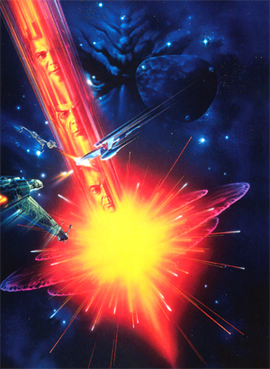
Star Trek VI: The Undiscovered Country is a 1991 American science fiction film directed by Nicholas Meyer, who also directed the second Star Trek film, The Wrath of Khan. It is the sixth feature film based on the 1966–1969 Star Trek television series. Taking place after the events of Star Trek V: The Final Frontier, it is the final film featuring the entire main cast of the original television series. The destruction of the Klingon moon Praxis leads the Klingon Empire to pursue peace with their longtime adversary, the Federation; the crew of the Federation starship USS Enterprise must race against unseen conspirators with a militaristic agenda.

Star Trek: Armada is a real-time strategy video game for Microsoft Windows developed and published in 2000 by Activision. The game's look and feel is based primarily on Star Trek: The Next Generation, and features a few of its main characters and ships. Playable factions include the United Federation of Planets, the Klingon Empire, the Romulan Star Empire and the Borg. The game received mixed to positive reviews and was noted for being one of the better Star Trek games to be made. A sequel, Star Trek: Armada II, was released on November 16, 2001.
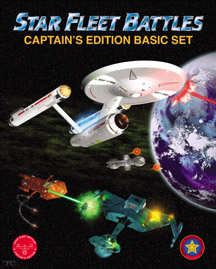
Star Fleet Battles (SFB) is a tactical board wargame set in an offshoot of the Star Trek setting called the Star Fleet Universe. Originally created in 1979 by Stephen V. Cole, it has had four major editions. The current edition is published by Amarillo Design Bureau as Star Fleet Battles, Captain's Edition.
In the Star Trek franchise, the Klingon Empire makes use of several classes of starships. As the Klingons are portrayed as a warrior culture, driven by the pursuit of honor and glory, the Empire is shown to use warships almost exclusively and even their support ships, such as troop transports and colony ships, are armed for battle. This contrasts with the exploration and research vessels used by Starfleet, the protagonists of the franchise. The first Klingon ship design used in The Original Series, the D7-class battlecruiser, was designed by Matt Jefferies to evoke a shape akin to that of a manta ray, providing a threatening and instantly recognizable form for viewers. The configuration of Jefferies's design featured a bulbous forward hull connected by a long boom to a wing-like main hull with the engine nacelles mounted on each wingtip. Though a variety of Klingon ships have appeared in Star Trek, their design generally conforms to this style. Most Klingon vessels were physically built as scale models, although later computer-generated imagery was used to create the models. In recent years, many of the original studio models have been sold at auctions.
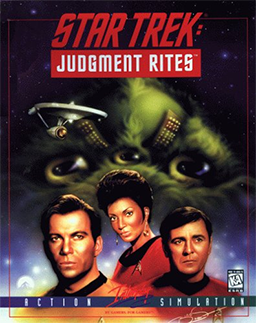
Star Trek: Judgment Rites is a computer game first produced by Interplay Productions in 1993, featuring the original cast of the classic Star Trek in a series of new adventures, including one featuring Trelane, the omnipotent child from the original episode "The Squire of Gothos". Judgment Rites uses the same MS-DOS game engine as the earlier Star Trek: 25th Anniversary; however, it had sharper graphics and sound, particularly with the CD-ROM edition. All of the initial cast members provided voices for their characters on the game in that edition. William Campbell also reprised his guest role as Trelane.

Star Trek is a text-based strategy video game based on the Star Trek television series (1966–69) and originally released in 1971. In the game, the player commands the USS Enterprise on a mission to hunt down and destroy an invading fleet of Klingon warships. The player travels through the 64 quadrants of the galaxy to attack enemy ships with phasers and photon torpedoes in turn-based battles and refuel at starbases. The goal is to eliminate all enemies within a random time limit.
Star Trek: The Next Generation Interactive VCR Board Game – A Klingon Challenge is a video board game created by Decipher, Inc., published by Milton Bradley in 1993. Based on the American science fiction television series Star Trek: The Next Generation, the game is set in the Star Trek universe, specifically on the USS Enterprise-D starship. The game utilizes a video tape that runs constantly while users play the board game portion. Events on the video tape combine with board game play to determine whether users win or lose the game. The video itself was directed by Les Landau and contains original footage filmed on the actual Star Trek: The Next Generation sets at Paramount Studios.
DECWAR is a multiplayer computer game first written in 1978 at the University of Texas at Austin for the PDP-10. It was developed from a lesser-known two-player version, WAR, adding multi-terminal support for between one and ten players. WAR and DECWAR are essentially multiplayer versions of the classic Star Trek game, but with added strategic elements. The game was later used, by scrubbing copyright notices and replacing them, as MegaWars on CompuServe and Stellar Warrior on GEnie. Both versions ran for years.

Star Trek: Strategic Operations Simulator is a space combat simulation arcade video game based on the original Star Trek television program and movie series, and released by Sega in 1983. Star Trek uses color vector graphics for both a 2D display and a 3D first-person perspective. The player controls the Starship Enterprise and must defend sectors from invading Klingon ships. The game includes synthesized speech
Empire is the name of a computer game written for the PLATO system in 1973. It is significant for being quite probably the first networked multiplayer arena shooter-style game. It may also be the first networked multiplayer action game.
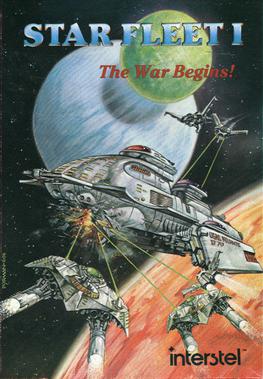
Star Fleet I: The War Begins is a 1984 strategy video game designed by Trevor Sorensen and developed by Interstel. It was released for Apple II, MS-DOS and Commodore 64. Versions for the Commodore 128, Atari ST, and Atari 8-bit computers were released in 1986 and versions for the Amiga and Mac were released in 1987. The game was successful enough to spawn sequels which are collectively known as the Star Fleet series.
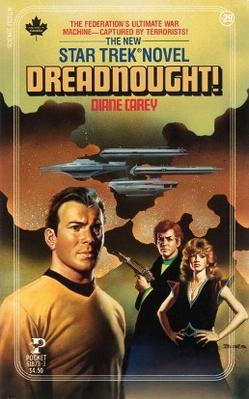
Dreadnought! is a Star Trek: The Original Series novel written by Diane Carey. It is written in the first person from the perspective of Lieutenant Piper.

Treklanta is an annual Star Trek convention based in Atlanta, Georgia, United States that places special emphasis on fan-based events, activities, programming and productions. It hosts the annual Miss Klingon Empire Beauty Pageant and Bjo Awards Ceremony.

Star Trek: 25th Anniversary is a 1992 Game Boy video game developed by Visual Concepts and published by Ultra, based upon the Star Trek universe. The game chronicles a mission of James T. Kirk and his crew of the USS Enterprise. Despite having the same name, the Game Boy version is not a port of the NES game or computer versions, and is in fact a completely different game. It was succeeded by Star Trek: The Next Generation for Game Boy, developed and published by Absolute Entertainment the following year.
The following outline is provided as an overview of and topical guide to Star Trek:

Star Trek III.4 is a 1979 video game designed by Lance Micklus and published by The Software Exchange for the TRS-80.
Trek-80 is a text-based video game written by Steve Dompier in 1976 and sold by Processor Technology for their Sol-20 computer and suitable S-100 bus machines.